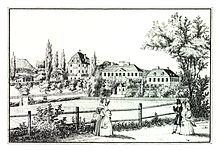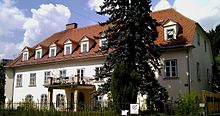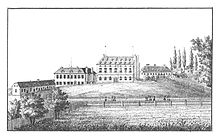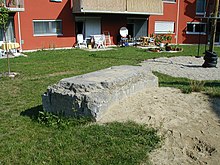Graz sugar factory
The Graz sugar factory , which was founded in 1825 and no longer exists today , was itself significant for the Styrian industrial history and stood on a historically remarkable area.
The history of the area
The Bonaparte Villa (Herdergasse 3; formerly Geidorfstraße 2) still exists today is an elongated, classicist building, the core of which goes back to the 16th century. The corner bay on the west side, resting on consoles, as well as the quarry stone cellar (but without the brick vaults erected in the 18th century) date from the original construction time.
Louis Bonaparte , Napoleon's brother and until 1810 King of Holland , went into exile in Austria after his abdication, where he called himself Count Ludwig von Saint Leu . In November 1810 he arrived in Graz . On August 17, 1811, he bought the villa in the Geidorf district with a large surrounding property. The previous owner was Count Vinzenz von Sauer, who had only bought it from Sigismund Freiherr von Schwitzen in 1801. He bought it from Aloisia Buresch (Edle von Greifenbach) in 1784. Until then it was part of the large Erdodic outdoor garden named after the Hungarian counts Erdödy. After a few enlargements, the ex-king's garden extended to today's Liebiggasse . However, he only lived on his property in Graz until 1813 and went to Italy for political reasons.
In May 1814, Ludwig's property passed into the possession of his brother Jérôme Bonaparte , who was King of Westphalia until 1813 and was named Graf von Harz. The latter sold it to Cäcilie Freiin von Bouvier in November 1814. In the meantime, the former manor house has become a barracks that was used as a hospital. In 1821 Prince Johannes von Liechtenstein acquired the entire property.
The sugar factory
Just five years later, the prince sold his new acquisition for only 2000 guilders to the "kk privileged sugar refinery in Graz" founded in 1825. Shortly afterwards, several buildings in the factory were destroyed by fire. It was replaced by a new building in 1828. The sugar factory then had several successive owners until it was bought by the Viennese bank Arnstein and Eskeles in 1837.
One of the modernizations carried out at that time was the first steam engine in Styria. It was used to pump water from the Kroisbach to the factory. In 1863 it became the property of a new joint stock company. The cane sugar that had been processed up to that point was increasingly being replaced by beet sugar. In the 1870s, the factory reached its maximum with an annual production of 11,000 tons and ended shortly afterwards. The former home of the ex-king was sold in April 1881.
The tower-like Temple of Venus, which was built in the 18th century and carried a “black Madonna” on one corner, was part of the sugar factory's property. It was owned by the doctor Anton Haas from 1820 to 1856 and was sold in 1873 to the stock corporation that owned the sugar factory. Around 1905 the temple of Venus was removed. The so-called Mozart Temple (the oldest Mozart monument in the world), built in the same area in 1797 , still exists today.
The later development of the area

The listed manor house (Herdergasse 3) was later a state school home and now houses the Styrian National Education Center , the Styrian Nature Conservation Union and the Styrian Mountain and Nature Guard. Until 2002 there was an allotment garden settlement in the immediate vicinity (on the other side of Herdergasse ), which was last in the possession of the church and still had small remains of the walls of the former sugar factory.
In 2002 the architects Martin Küng and Peter Reitmayr built a large housing estate. A single piece of the foundation of the former factory was architecturally integrated into the green space inside. The avenue trees that bordered the factory area to Mariatrosterstrasse (today Heinrichstrasse ) gradually disappeared. The last ones were badly damaged and removed by a major storm on August 29, 2003.
literature
- Robert Janeschitz-Kriegl: Ludwig Bonaparte's property in today's Heinrichstrasse in Graz and the former kk-privileged sugar refinery there . In: Journal of the Historisches Verein für Steiermark , vol. 56 (1965), pp. 141–148.
Web links
- Styrian national education center
- Nature Conservation Association of Styria
- Styrian mountain and nature watch
Individual evidence
- ↑ The art monuments of the city of Graz. The secular buildings of the II., III. and VI. District . In: Bundesdenkmalamt (Hrsg.): Austrian Art Topography . 1st edition. tape LX . Verlag Berger, Horn / Vienna 2013, ISBN 978-3-85028-603-9 , Als der II., III. and VI. District still belonged to the Graz area, S. XVIII .
- ↑ http://www.graz.at/cms/dokumente/10056067_419305/de5ac366/MaerzBIG2006.pdf
- ↑ https://www.news.at/a/die-mozart-denkmaeler-erstes-monument-graz-salzburg-111312
Coordinates: 47 ° 4 ′ 51.5 ″ N , 15 ° 27 ′ 13 ″ E



